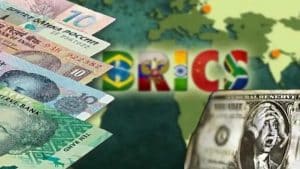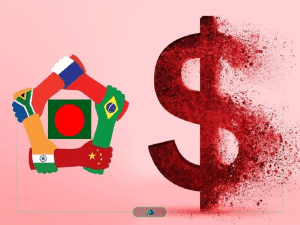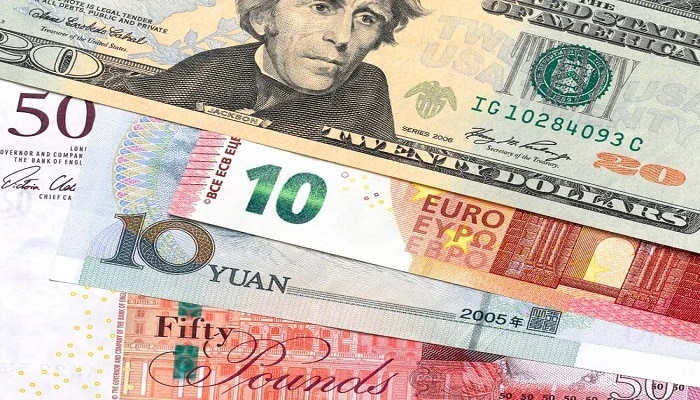PNN – International concerns about the misuse of the US to hit the economy of different countries by using the dominance of the dollar, as well as Washington’s unilateral sanctions against some countries, have prompted countries around the world to make plans to move away from the world dominated by the dollar.
According to Pakistan News Network, experts believe that a combination of political and economic reasons can slowly end the supremacy of the dollar, which was considered the world’s reserve currency since World War II.
Quoting the International Monetary Fund, “Market Insider” writes: More than 60% of international currency reserves are kept in dollars, and this currency is currently the most widely used currency for business in the world.
According to this report, the sanctions imposed by the West against Russia due to the Ukraine war have made other countries more aware of its possible consequences and distance themselves from the dollar.
Some countries, such as Brazil, Argentina, Bangladesh and India, choose to trade with currencies and backing assets such as the Chinese Yuan and Bitcoin.
On the other hand, while geopolitical conditions encourage countries to seek alternative currencies, there have long been concerns about the dollar’s excessive dominance in global trade and finance.
In this report, three reasons have been mentioned that have prompted countries around the world to prepare plans to move away from the dollar-dominated world.
First, the monetary policy adopted by the United States has a great influence on the rest of the world. Currently, the United States is the world’s reserve currency exporter, which is also the dominant currency in international trade and payment systems.

According to the Wilson Center think tank, as a result of the dollar’s impact on the global economy, it has often been seen that this currency is overvalued.
This position gave the United States what Valéry Giscard Destin, the former president of France from 1974 to 1981, called an “extravagant privilege.”
One aspect of this advantage is that if the United States cannot default on its debt at a time when the value of the dollar falls sharply, it will not go into crisis. Because Washington can simply export more money.
This also means that countries around the world should closely follow the economic and monetary policies of the United States to prevent its effects on their economies.
Some countries, including India, have said they are fed up with US monetary policies holding them hostage. To the extent that the United States has been an irresponsible exporter of the world’s reserve currencies.
A task force at the Reserve Bank of India is now trying to use the Indian rupee for business transactions.
According to the report, this position is in line with the view of Indian Prime Minister Narendra Modi.
The second issue is that a strong dollar is very expensive for emerging countries.
This means that the increase in the value of the dollar against most currencies around the world makes imports more expensive for emerging countries.
In Argentina, political pressure and reduced exports have led to a decrease in US dollar reserves and pressure on the currency unit of the Argentine peso, which in turn has increased inflation.
According to Reuters, the country’s economy minister said on Wednesday that this led Argentina to import products from China using yuan instead of US dollars.
According to economists at Allianz, an international financial services company, the strengthening of the US dollar weakens its role as a reserve currency. Because when access to dollars becomes more expensive, borrowers will look for alternatives.

According to the report, Brazilian President Luiz Inacio Lula da Silva has been one of the staunchest supporters of the launch of alternative trade settlement currencies, eventually prompting Brazil, Russia, India, China and South Africa to distance themselves from the US dollar.
The third issue is that global trade and oil demand are diversifying, and this issue can put petrodollars at risk.
One of the key reasons for the US dollar becoming the global reserve currency is that the Persian Gulf countries in the Middle East used the US dollar for oil trade. Because as long as they were doing oil business, this currency was considered a widely used commercial currency.
This agreement was formalized in 1945 when Saudi Arabia and the United States reached a historic agreement in which Saudi Arabia would only sell its oil to the United States using US dollars.
In return, Saudi Arabia will reinvest excess dollar reserves in US treasuries and corporations.
But then with the rise of the shale oil industry, the United States became energy independent and a net oil exporter.
A structural change in the oil market caused by the shale oil revolution could damage the US dollar’s role as the world’s reserve currency, as oil exporters, who play a major role in the dollar’s position, would have to reposition themselves.
China’s role in de-dollarization
According to Watchergro news website, Russia, China and India, which are members of the BRICS alliance, are looking to replace the US dollar with local currencies in global trade.
China has been successful in persuading other developing countries to abandon the US dollar and use local currencies to settle international transactions.
It has convinced Saudi Arabia, Pakistan, Russia, India and other African countries to use the yuan instead of the US dollar for bilateral trade.
On the other hand, Russia gives discounts for the sale of its crude oil to developing countries and in this way bypasses the US sanctions. Russia requires other countries to make their oil payments in yuan or rubles.
In addition, India is signing new trade agreements with the UAE and other countries to pay in rupees instead of US dollars in global transactions.
These actions show that the three BRICS member countries intend to prioritize their local currencies instead of the US dollar.
BRICS was formed in 2001 with a group of countries that are rapidly developing in the world economy, i.e. Brazil, Russia, India, China and South Africa. These countries make up 27% of the world’s area and house 42% of the world’s population. These countries are also members of the Group of 20, which is considered to be a larger group of major and important economies in the world.

